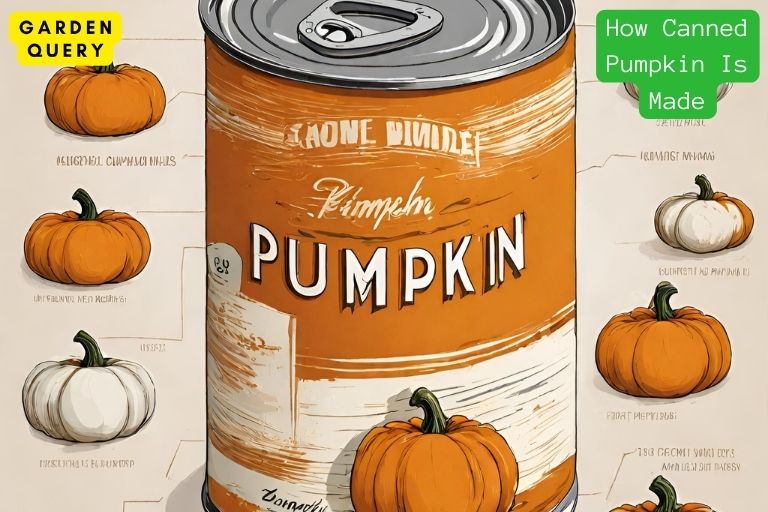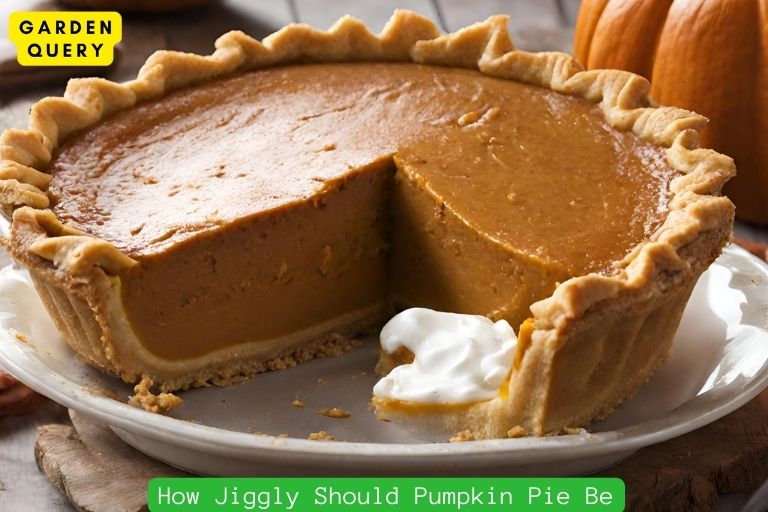How Canned Pumpkin Is Made?
Canned pumpkin is made through a process involving the selection, cooking, pureeing, and canning of pumpkin flesh, ensuring preservation and convenience.
The process of making canned pumpkin starts with selecting pumpkins known for their flavor and quality. The pumpkins are washed, cut, and cooked until soft, after which the flesh is pureed into a smooth consistency.
This puree undergoes a heating process to ensure safety and preservation, after which it’s packed into cans and sealed for distribution.
Canned pumpkin offers a convenient and long-lasting way to enjoy the flavor and nutrients of fresh pumpkin for various culinary purposes.
Key Takeaway
Canned Pumpkin Is Made
What is canned pumpkin and its uses
Canned pumpkin is a popular ingredient used in various recipes, especially during the fall season. It is made from the flesh of ripe, sweet pumpkins that are grown specifically for canning purposes.
The pumpkin flesh is cooked, pureed, and then canned to preserve its freshness and taste. Canned pumpkin is a convenient alternative to fresh pumpkin, as it is available year-round and can be easily stored in your pantry until needed.

The uses of canned pumpkin are extensive and versatile. It is commonly used as a key ingredient in pumpkin pies, muffins, bread, soups, and even savory dishes like pasta sauces and curries.
Its mild flavor and creamy texture make it a favorite addition to many recipes. Canned pumpkin can also be used as a substitute for oil or butter in certain baked goods, adding moisture and nutritional value.
The process of making canned pumpkin
The process of making canned pumpkin begins with carefully selecting and harvesting ripe pumpkins.
These pumpkins are then washed and sanitized to remove any dirt or impurities. Once cleaned, the pumpkins are cut open, and the seeds and pulp are removed.
The pumpkin flesh is then separated from the skin, either by hand or using machinery.
The pumpkin flesh is cooked until it becomes soft and tender. This is typically done through gentle steaming or roasting.
The cooked pumpkin is then pureed using industrial blenders or food processors to achieve a smooth consistency.
To ensure the quality and safety of the product, the pureed pumpkin goes through a process called canning.
The puree is scooped into cans, and the cans are then sealed and sterilized. This process helps to preserve the pumpkin’s flavor, texture, and nutritional value, allowing it to have a long shelf life.
Once the cans are sealed, they are typically labeled with the necessary information, such as the brand name, nutritional facts, and expiration date.
The canned pumpkin is then packaged and prepared for distribution to grocery stores and other retailers.
Canned pumpkin is a convenient and versatile ingredient used in various recipes. The process of making canned pumpkin involves selecting ripe pumpkins, cooking and pureeing the flesh, and then sealing the puree in cans.
This ensures its freshness and allows it to be enjoyed throughout the year. So, the next time you’re looking to add some pumpkin goodness to your dishes, reach for a can of canned pumpkin and let your culinary creativity shine.
Harvesting and selecting pumpkins
Choosing the right variety of pumpkins
When it comes to making canned pumpkin, selecting the right variety of pumpkins is crucial. Not all pumpkins are suitable for canning, as some have a higher water content and are less flavorful.
The most commonly used pumpkin variety for canning is the Dickinson pumpkin, which has a dense, sweet flesh that is perfect for purees and pies.
Other varieties, such as the Howden pumpkin, are also used for their rich flavor and smooth texture.
The importance of ripe pumpkins
To ensure the best quality canned pumpkin, it is essential to use only ripe pumpkins for the process. Ripe pumpkins will have a deep orange color, firm skin, and a hollow sound when tapped.
These characteristics indicate that the pumpkins are fully matured and will have the optimal flavor and texture.
Once the pumpkins have been selected, they are harvested from the fields. The harvesting process involves carefully cutting the pumpkins from their vines to avoid damaging the fruit.
It is crucial to handle the pumpkins with care to prevent bruising or puncturing, as this can affect the quality of the canned pumpkin.
After harvesting, the pumpkins are brought to the processing facility, where they undergo a series of steps to transform them into canned pumpkin.
These steps include cleaning, cutting, cooking, pureeing, and finally canning the pumpkin puree.
The cleaning process involves removing any dirt or debris from the pumpkins’ skin. Next, the pumpkins are carefully cut into halves or quarters, depending on their size.
The seeds and stringy pulp are scooped out, leaving only the solid flesh behind.
The pumpkin pieces are then cooked either by boiling or steaming. This softens the flesh and makes it easier to puree.
Once cooked, the pumpkin is blended into a smooth puree using industrial-grade machinery. The puree is then packed into cans and sealed to preserve its freshness.
The canned pumpkin is then heat-treated, which ensures that any bacteria or microorganisms are eliminated, ensuring product safety.
The canned pumpkin is labeled, boxed, and ready to be distributed to consumers.
The process of making canned pumpkin involves careful selection, harvesting, and processing to ensure the highest quality product.
The result is a versatile ingredient that can be used in a variety of recipes, from pies to soups and everything in between.
Cleaning and preparation
Preparing canned pumpkin involves several steps to ensure its quality and taste. Here’s a closer look at how canned pumpkin is made.
Removing the stems and skin
The first step in the process is removing the stems and skin from the pumpkins. This is usually done using specialized equipment that can efficiently remove these unwanted parts.
Removing the stems helps create a smoother and more uniform pumpkin puree, while removing the skin ensures a better texture and taste.
Cutting and seeding the pumpkins
Once the stems and skin are removed, the pumpkins are cut into smaller, manageable pieces. This allows for easier handling during the cooking process.
The pumpkins are then seeded to remove the inner pulp and seeds. The seeds can be saved for roasting or for other uses, while the pulp is discarded.
The cut and seeded pumpkins are then ready for cooking. There are various methods of cooking pumpkins, including boiling, baking, or steaming.
The choice of cooking method can depend on the final desired texture and taste.
After cooking, the pumpkin pieces are mashed or pureed to create a smooth consistency. This helps achieve the desired texture for the canned pumpkin.
The pureed pumpkin is then ready to be processed and canned.
Once the pumpkin puree is prepared, it goes through a series of quality control checks to ensure it meets the industry standards. This includes checking for consistency, taste, and appearance.
The final step in the process is canning the pumpkin puree. The puree is carefully packed into cans, ensuring that the product is properly sealed to maintain its freshness and quality.
The cans are then sterilized to kill any bacteria or microorganisms and extend the shelf life of the product.
Preparing canned pumpkin involves the careful removal of stems and skin, cutting and seeding the pumpkins, cooking, pureeing, and finally canning the pumpkin puree.
Each step is crucial in creating a high-quality product that can be enjoyed in various recipes, from delicious pumpkin pies to savory soups.
Cooking and pureeing
Many people enjoy the rich, smooth taste of canned pumpkin in their favorite fall recipes, such as pumpkin pie and pumpkin bread. But have you ever wondered how canned pumpkin is made?
Boiling or roasting the pumpkin
To start the process, mature pumpkins are harvested and transported to the processing facility. The pumpkins are thoroughly cleaned to remove any dirt or debris.
Then, they are typically either boiled or roasted to soften the flesh and enhance the flavor.
If boiling is the chosen method, the pumpkins are submerged in large vats filled with boiling water and cooked until tender.
On the other hand, if roasting is preferred, the pumpkins are cut into halves or quarters, and the flesh side is placed face down on baking sheets.
They are then roasted in an oven until the flesh is easily pierced with a fork.
Blending and pureeing the cooked pumpkin
Once the pumpkins are cooked, the next step is to remove the skin and seeds. The flesh is separated from the rest of the pumpkin and transferred to large blending machines or food processors.
These machines blend and puree the cooked pumpkin until it reaches a smooth and consistent texture.
After the blending process, the pureed pumpkin is strained to remove any remaining fibers or lumps. This helps ensure a velvety texture in the final product.
The strained pumpkin puree is then carefully packaged into cans, along with any necessary preservatives to maintain its freshness.
The cans are sealed, labeled, and sent for pasteurization. Pasteurization is a heat treatment process that helps extend the shelf life of the canned pumpkin by destroying any harmful bacteria.
This makes canned pumpkin a safe and convenient option for use in various recipes throughout the year.
The production of canned pumpkin involves cooking and pureeing mature pumpkins, followed by straining and packaging the smooth puree into cans.
The pasteurization process ensures its safety and extends its shelf life. Now that you know how canned pumpkin is made, you can appreciate the convenience and versatility it offers for your favorite fall dishes.
Canning the pumpkin
If you’ve ever wondered how your favorite canned pumpkin is made, you’re in for a treat! Canning pumpkin is a popular way to preserve the delicious fall fruit, making it readily available year-round.
Through a carefully controlled process, pumpkin is transformed into a convenient and versatile product that can be used in a variety of recipes. Let’s take a closer look at how canned pumpkin is made.
The canning process and its benefits
The canning process begins with selecting the finest pumpkins, usually grown specifically for canning purposes.
These pumpkins are then washed, cleaned, and cut into pieces. The pieces are then cooked to soften the flesh, making it easier to process and blend.
After cooking, the pumpkin is pureed and strained to remove any lumps or fibrous parts. This results in a smooth and creamy consistency.
The pureed pumpkin is then measured and added to cans, along with any necessary preservatives to ensure freshness and extend shelf life.
One of the main benefits of canning pumpkin is the convenience it offers. With canned pumpkin, you don’t have to worry about finding fresh pumpkins in season or spending time preparing and cooking them.
You can simply open a can and use the pumpkin as needed. It’s a time-saving solution for busy cooks and bakers.
Preserving the flavor and nutrients
The canning process is carefully designed to retain the natural flavor and nutrients of the pumpkin. Special care is taken to prevent any loss of color, taste, or texture during processing.
This ensures that the canned pumpkin maintains its delicious flavor and nutritional value.
Canned pumpkin is a rich source of vitamins A and C, as well as fiber. It’s a great addition to a balanced diet and can be used in a variety of recipes, including pies, muffins, soups, and smoothies.
Canned pumpkin is made through a meticulous process that involves selecting the best pumpkins, cooking and pureeing the flesh, and canning it for long-term storage.
The result is a convenient and flavorful product that can be used all year round. So the next time you reach for a can of pumpkin to make your favorite fall recipe, you can appreciate the effort that goes into creating this beloved ingredient.
Packaging and storage
How canned pumpkin is packaged
Canned pumpkin is a convenient and versatile ingredient that many people enjoy using in their favorite fall recipes, such as pumpkin pie or pumpkin bread.
But have you ever wondered how canned pumpkin is made and packaged? Let’s take a closer look.
The process begins with selecting the right pumpkins, which are specifically grown and harvested for canning purposes.
These pumpkins are carefully chosen for their flavor, texture, and color. Once harvested, they are transported to the processing facility.
At the facility, the pumpkins are thoroughly cleaned and washed to remove any dirt or debris. They are then cut into smaller pieces, removing the skin and seeds.
The pumpkin flesh is cooked until tender, either through boiling or steaming. This heat treatment not only helps to soften the flesh but also enhances the flavor.
Once the pumpkin is cooked, it is pureed to achieve a smooth and consistent texture. The puree is then transferred into cans, which are sealed to ensure the quality and freshness of the product.
The cans are typically lined with a thin layer of food-grade enamel to prevent interaction between the pumpkin and the metal can. This helps to maintain the pumpkin’s flavor and color.
Proper storage and shelf life
Canned pumpkin has a long shelf life if stored correctly. It is important to check the expiration date printed on the can and follow the storage guidelines provided.
Unopened cans of pumpkin can be stored in a cool, dry place such as a pantry for up to several years.
Once opened, any unused portion of the canned pumpkin should be transferred to a clean, airtight container and refrigerated.
It is recommended to consume the leftover pumpkin within three to five days to ensure its freshness and quality.
It's worth noting that canned pumpkin does not require freezing for storage. Unlike fresh pumpkin, which has a limited shelf life due to its high moisture content, canned pumpkin is already cooked and preserved, making it shelf-stable.
Whether you’re a fan of pumpkin desserts or savory dishes, understanding how canned pumpkin is made and stored can help you make the most out of this versatile ingredient.
So next time you reach for a can of pumpkin puree, you’ll have a deeper appreciation for the meticulous process behind it.
- Best Therapists In Dallas - February 1, 2024
- Holly Willoughby Husband: Holly Willoughby’s Love Story - January 30, 2024
- Holly Willoughby Dress: 5 Style Secrets and 7 Must-Know Career Milestones - January 30, 2024





